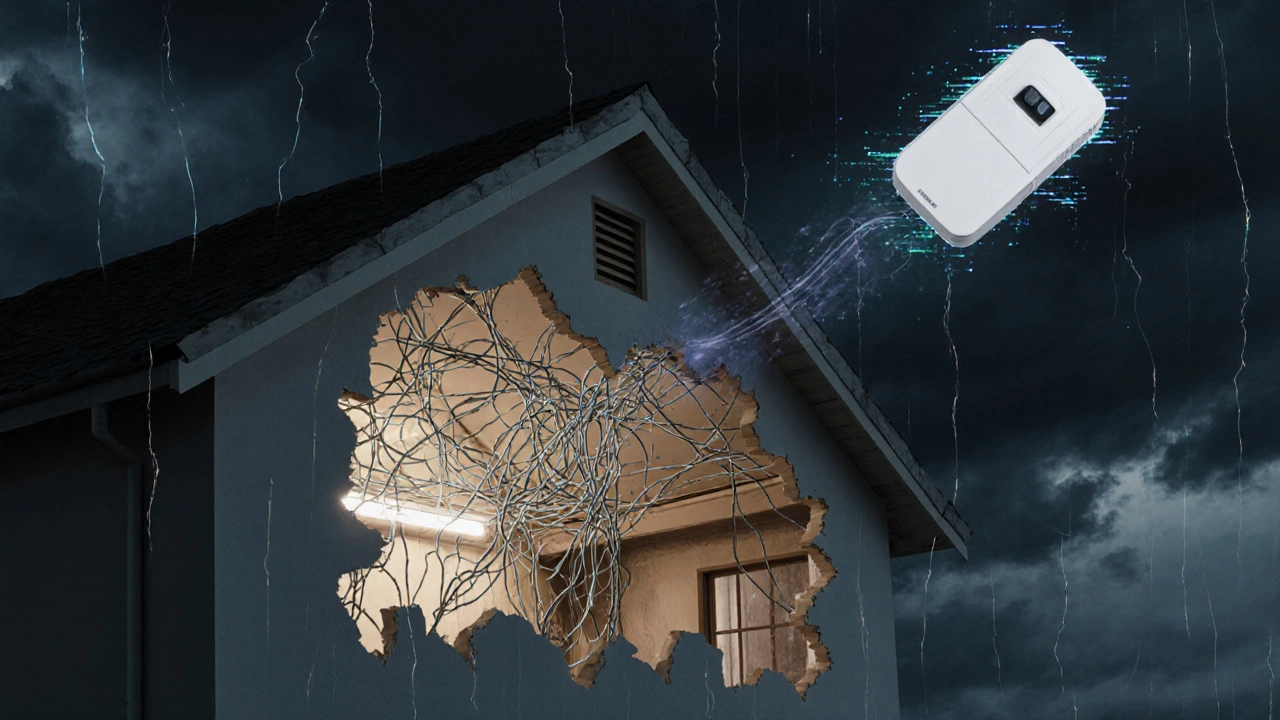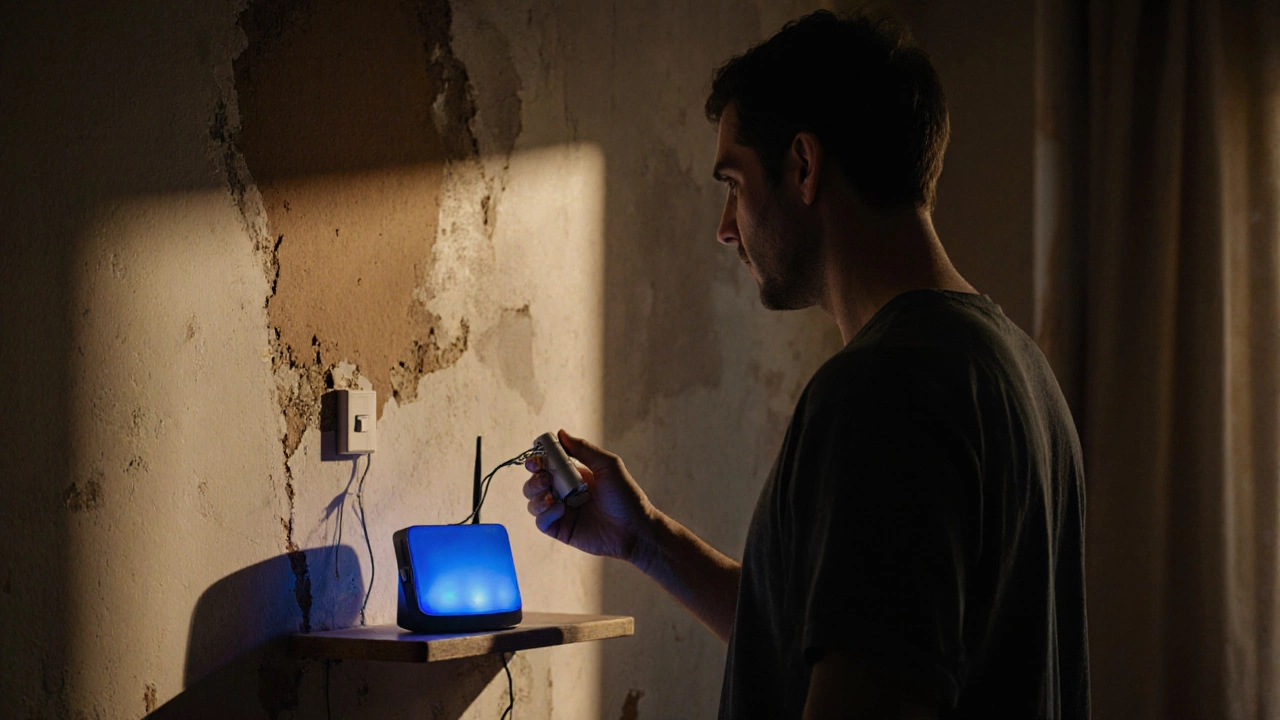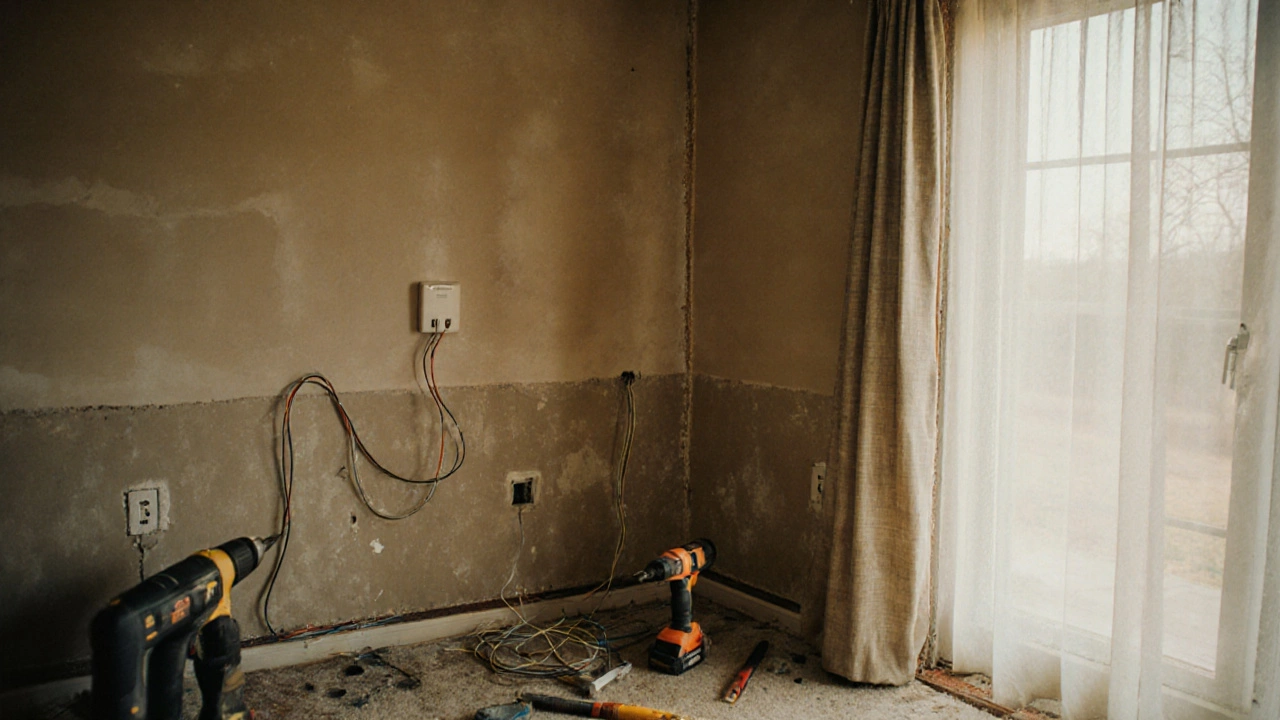Wired vs Wireless Alarm System Cost Calculator
Why This Matters
Wired systems have hidden costs that often exceed initial savings. Our calculator includes:
- Installation labor and wall repairs
- Annual false alarm fines ($150 per incident)
- 35% higher repair costs for wired systems
- Additional costs for remote access and backup power
Wired alarm systems used to be the gold standard for home security. Back in the 90s and early 2000s, if you wanted your house protected, you got wires running through the walls. But today? Most people are walking away from them. Why? Because the downsides of wired alarms are no longer worth the trade-offs-especially when wireless systems now do everything better, cheaper, and without the mess.
Installation Is a Nightmare
Putting in a wired alarm system isn’t like plugging in a smart speaker. It’s construction work. For a typical 2,000-square-foot home, you’re looking at 8 to 12 hours of professional labor. Electricians have to drill holes, fish wires through walls, ceilings, and floors, and then patch everything back up. In older homes, that’s bad enough. In homes built after 1980, it’s worse-fire blocking and insulation often block access to wall cavities, making hidden wiring impossible.And it’s not just time. It’s cost. Professional installation for a basic wired system with eight sensors runs $1,200 to $2,500. Compare that to a DIY wireless system: $300 to $600. Add a motion sensor later? Wired costs $150 to $250 per sensor, including labor. Wireless? $25 to $50, and you snap it on yourself. Most homeowners don’t realize they’re paying for drywall repair, paint touch-ups, and hidden labor charges until they get the bill. One survey found 78% of retrofitted wired systems needed professional wall repairs afterward-costing $300 to $800 extra.
You Can’t Move It
Wired alarm systems are permanent. They’re not designed to be taken with you when you move. Trying to remove them usually means tearing out wires, leaving holes, and damaging sensors. About 70% of the components become useless after removal. Only 12% of homeowners who tried moving their wired system succeeded without major damage. Meanwhile, 88% of people with wireless systems moved theirs without a hitch.And if you do manage to salvage parts? You’ll still need a new control panel. Most wired panels max out at 32 zones. Add a new door sensor? You might need to replace the whole panel-costing $400 to $700. Wireless systems? Just pair the new sensor. No tools. No mess. No upgrade fees.
Wires Are Ugly and Hard to Hide
You can’t ignore the look. Wired systems mean wires. Visible along baseboards, across ceilings, snaking behind furniture. A 2023 survey found 68% of wired system owners had obvious wiring they couldn’t hide. Wireless? Only 7% reported visible hardware.Trying to hide wires in existing homes often requires opening walls-something 45% of homes built after 1980 physically won’t allow. So you’re stuck with ugly cables. And if you want them gone? You’re looking at $285 per job just for paint and drywall repair. That’s not security-that’s interior design debt.

No Remote Access Without Paying More
Want to check if your alarm is armed from your phone? Turn it off when you forget? Get a notification if someone opens the front door while you’re at work? None of that comes built into a wired system.To get remote access, you need an add-on module-$150 to $300 extra. Even then, it’s clunky. A 2022 study found 84% of wired system owners were frustrated by the lack of smartphone control. Meanwhile, only 11% of wireless users felt that way. What’s worse? Over 76% of wired system owners ended up buying a separate wireless system just to get remote features. That’s not an upgrade-it’s double-dipping. You pay once for the wired system, then another $450 on average for a wireless backup.
They’re Easier to Disable
One of the big claims for wired systems was reliability. No batteries to die. No signals to jam. But here’s the catch: intruders don’t need to hack the signal. They just need to cut a wire.Most wired systems rely on a single phone line or power cable for monitoring. That line? Usually accessible in the basement or utility closet. In 92% of single-family homes, it’s easy to reach. Cut the line, and the alarm goes silent. A 2022 case study of 127 break-ins found that 33% involved cutting alarm wiring-and 89% of those attempts worked.
Wired systems also fail during power outages-100% of the time-unless you install a backup battery. And that battery? It’s extra. $200 to $400 more. Wireless systems, on the other hand, have built-in batteries that last 24 to 72 hours without power. No extra cost. No extra wiring. Just works.
More False Alarms, More Fines
Wired systems are prone to false alarms. Not because of bad sensors, but because of bad wiring. Loose connections. Rodent damage. Moisture in the walls. Power surges. A 2023 reliability study showed wired systems have 23% more false alarms than wireless ones.That’s not just annoying. It’s expensive. Many cities now fine homeowners for repeated false alarms. One homeowner in Adelaide got hit with a $150 fine after three false alarms in six months-all caused by a frayed wire behind the garage. The same survey found 58% of wired system owners had at least one false alarm per year. For wireless? Only 22% did.

Higher Maintenance, Higher Costs
Wired systems need more care. A 2023 study showed they require professional service calls 1.7 times more often than wireless systems in the first five years. And when they break? It’s not a quick swap. You need someone to trace the wire, find the break, splice it, test it, and reseal the wall. Average repair cost? 35% higher than wireless.And the biggest culprit? Wiring issues. 41% of all wired system service calls were for loose connections, rodent-chewed cables, or water damage. For wireless? Only 9%. You’re paying for maintenance on a system that’s literally rotting inside your walls.
The Industry Has Moved On
The numbers don’t lie. In 2005, wired systems made up over 80% of new home security installs. Today? Just 15%. That’s not because people are ignoring reliability-it’s because wireless has caught up and surpassed it.Dr. Samuel Chen from the University of Michigan’s Smart Home Institute put it plainly: “The reliability gap between wired and wireless systems has virtually disappeared.” Former ADT CTO John Smith wrote in 2023 that wired systems now only make sense in specialized commercial buildings-with controlled power and protected conduits. For homes? Not anymore.
Consumer Reports’ 2023 survey gave wireless systems a 32% higher customer satisfaction score. Why? Installation ease. Remote control. No mess. No surprises. And the market is responding. The wired security segment is projected to shrink by 3.7% every year through 2030. Wireless? Growing at 12.4% annually.
On Reddit, one user summed it up: “Paid $2,100 for a wired system. Spent $580 on repairs in a year. My neighbor got a wireless system for $400 that does everything mine does-plus remote access.” That’s the new reality.
Is a Wired System Ever Worth It?
There are two cases where wired might still make sense. One: you’re building a new home from scratch and can run wires during construction. Two: you’re securing a high-risk commercial property with strict physical security requirements. For 99% of homeowners? No.Wired alarms were designed for a time when wireless was unreliable and expensive. That time is over. Today’s wireless systems use encrypted signals, long-lasting batteries, and smart diagnostics. They’re more flexible, cheaper to install, easier to expand, and safer from tampering. And they work when the power goes out.
If you’re still considering a wired alarm, ask yourself: Are you paying for reliability-or just tradition? Because the truth is, you’re paying for hassle, hidden costs, and outdated tech. There’s no reason to choose wired unless you’re stuck with it.
Are wired alarm systems more reliable than wireless ones?
Not anymore. While wired systems used to be seen as more reliable because they didn’t rely on batteries, modern wireless systems now match or exceed their reliability. Wireless sensors use encrypted signals, low-power electronics, and backup batteries that last 24 to 72 hours during outages. Wired systems, on the other hand, are vulnerable to power cuts, wiring damage, and signal interference from moisture or rodents. In real-world use, wireless systems have fewer false alarms and fewer service calls.
Can I add sensors to a wired alarm system later?
You can, but it’s expensive and complicated. Most wired control panels support only 32 zones. Adding a new sensor often means running new wires through walls-which requires professional labor and can cost $150 to $250 per sensor. In many cases, you’ll need to upgrade the entire control panel, which costs $400 to $700. Wireless systems let you add sensors with a simple pairing process, often for under $50 each.
Why do wired alarms have more false alarms?
Wired alarms suffer from wiring degradation. Over time, connections loosen, wires get chewed by rodents, or moisture seeps into junction boxes. Power surges can also trigger false signals. These issues don’t exist in wireless systems, which use sealed sensors and digital communication. A 2023 study found wired systems generate 23% more false alarms than wireless ones, leading to higher risks of municipal fines in cities with false alarm ordinances.
Can I install a wired alarm system myself?
Technically, yes-but it’s not practical. Wiring requires electrical knowledge, access to wall cavities, and tools like fish tapes and conduit benders. Most homeowners don’t have the skills or access to run wires safely through finished walls. Even if you do, mistakes can cause signal loss, short circuits, or fire hazards. DIY wireless systems are plug-and-play, with no tools needed. For most people, self-installation isn’t an option with wired systems-it’s a risk.
Do wired alarm systems work during a power outage?
No, not unless you add a backup battery. Wired systems rely on household power, and when the electricity goes out, the alarm shuts down. To keep it running, you need a separate battery backup system, which adds $200 to $400 to the cost. Wireless systems come with built-in batteries that last 24 to 72 hours without power. That’s why wireless systems are far more reliable during storms or blackouts.
Is it cheaper to repair a wired alarm system than replace it?
Usually not. Repairs for wired systems involve labor-intensive tasks like tracing broken wires, replacing damaged cables, and patching walls. The average repair cost is 35% higher than for wireless systems. In many cases, the cost of multiple repairs over a few years adds up to more than the price of a new wireless system. Most homeowners who’ve had repeated wired system issues end up replacing the whole setup with a wireless alternative anyway.

